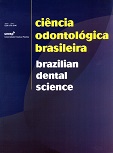Selamento apical em obturações retrógradas. Estudo em dentes bovinos empregando solução corante Rodamina B
DOI:
https://doi.org/10.14295/bds.2007.v10i2.338Abstract
A capacidade de selamento de materiais utilizados em endodontia tem sido avaliada por testes de infiltração com corantes. A proposta deste estudo foi avaliar o selamento apical de materiais utilizados em obturações retrógradas empregando modelo experimental com dentes bovinos. Quarenta incisivos bovinos recém extraídos, com raízes retas tiveram seus canais radiculares instrumentados e obturados. Após a secção da porção apical, cavidades retrógradas foram preparadas com pontas de retropreparo ultra-sônico e os dentes divididos aleatoriamente em três grupos experimentais (n=12) e quatro controles (n=4). Foram utilizados os materiais: Grupo I - MTA Angelus Cinza; Grupo II - Cimento de Óxido Zinco e Eugenol; Grupo III - Sealer 26. Em seguida, os dentes foram imersos em solução de Rodamina B a 0,2 % por 48 horas em ambiente com vácuo. Decorrido este período, os dentes foram seccionados longitudinalmente e as imagens digitalizadas analisadas por meio do programa Image Tool. Grupos controle positivo e negativo apresentaram infiltração máxima ou zero, respectivamente. Os resultados obtidos foram submetidos ao teste ANOVA e de Tukey demonstrando menor infiltração apical para o Sealer 26 (p<0,05). MTA e OZE apresentaram infiltração apical semelhante (p>0,05). Conclui-se que o cimento Sealer 26 proporciona selamento apical superior ao MTA e OZE, sendo o modelo experimental com dentes bovinos viável para a avaliação do selamento apical em obturações retrógradas.Downloads
Downloads
Published
How to Cite
Issue
Section
License
Brazilian Dental Science uses the Creative Commons (CC-BY 4.0) license, thus preserving the integrity of articles in an open access environment. The journal allows the author to retain publishing rights without restrictions.
=================




























